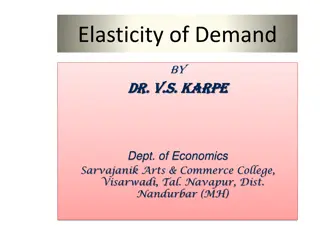Understanding Elasticity in Economics
Elasticity in economics refers to the responsiveness of demand to price changes. A more elastic curve results in larger quantity changes for small price changes, while a less elastic curve requires larger price changes to affect quantity consumed. The elasticity of demand can be measured by calculating the percentage change in quantity divided by the percentage change in price. Studying elasticity over a curve involves determining elasticity using specific formulas. Additionally, price elasticity of demand is essential in analyzing consumer behavior in response to price fluctuations.
Download Presentation

Please find below an Image/Link to download the presentation.
The content on the website is provided AS IS for your information and personal use only. It may not be sold, licensed, or shared on other websites without obtaining consent from the author. Download presentation by click this link. If you encounter any issues during the download, it is possible that the publisher has removed the file from their server.
E N D
Presentation Transcript
ELASTICITY Chapter 4/2 1 Hanan-107
What is Elasticity? Elasticity refers to the degree of responsiveness in demand in relation to changes in price If a curve is more elastic, then small changes in price will cause large changes in quantity consumed. If a curve is less elastic, then it will take large changes in price to effect a change in quantity consumed 2 Hanan-107
3 Hanan-107
At the extremes, a perfectly elastic curve will be horizontal, and a perfectly inelastic curve will be vertical. 4 Hanan-107
How Is Elasticity Measured? Elasticity = (% Change in Quantity)/(% Change in Price) I. Noora had 10 pens when the price was 1 R BUT she had 6 only when the price raise to 1.5 R % Change in Quantity = (6-10)/10 = -0.4 = -40% % Change in Price = (1.50-1)/1 = 0.5 = 50% (-40%)/(50%) = -0.8 Elasticity of Demand = 0.8 5 Hanan-107
Elasticity to study elasticity over a curve, rather than at a specific point, is to calculate elasticity using the following formula: Elasticity = (Change in quantity/Average quantity) / (Change in price/Average price) Elasticity = ((Q1 - Q2) / (Q1 + Q2)/2 )) / ((P1 - P2)/( (P1 + P2)/2)) Elasticity = (Q1 - Q2) / (P1 - P2)* (P1 + P2)/2)/ (Q1 + Q2)/2 6 Hanan-107
The price falls to $19.50 and the quantity demanded increases to 11 pizzas an hour. The price falls by $1 and the quantity demanded increases by 2 pizzas an hour. 7 Hanan-107
Average Price and Quantity you have the following table : Calculate the price elasticity of demand: The New Point Point The Original The Average P1= 20.5 P2 = 19.5 P aver= 20 Q1= 9 Q 2 = 11 Q aver= 10 8 Hanan-107
9 Hanan-107
Price Elasticity of Demand The price elasticity of demand is % Q/ % P = (1/5)/(1/20) = 20/5 = 4 10 Hanan-107
. Example 2: Elasticity of Demand Suppose we were looking at the demand for McDonald s Hamburgers at a particular location. When they had a p=$0.75 they had a Qd=1000 hamburgers per day. The owner of the McDonald s decided to raise price to p=$1.00 and found that demand dropped to Qd=900 per day. Calculate the elasticity of demand for hamburgers at this McDonald s. Elasticity of demand =% Q / % P= [(Q2-Q1) / Qave] / [(P2-P1) / Pave] Applying the above formula to the data given we get: [(900- 1000)/950]/[(1.00-.75)/.875] -0.368 11 Hanan-107
Elasticity Along a straight- Line Demand Curve 12 Hanan-107
Elasticity Along a straight- Line Demand Curve Elasticity decreases as the price falls and quantity demanded increases. At midpoint of a demand curve , the demand is unit elastic. Above the midpoint of a demand curve , the demand is elastic. Below the midpoint of a demand curve , the demand is inelastic. 13 Hanan-107























